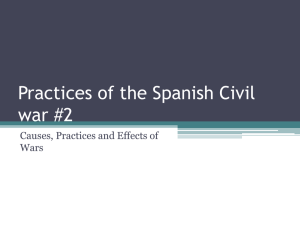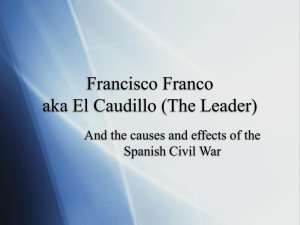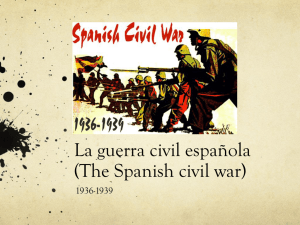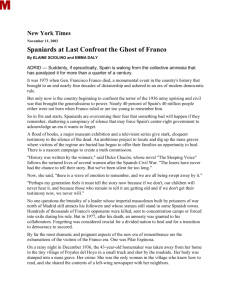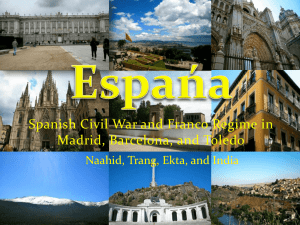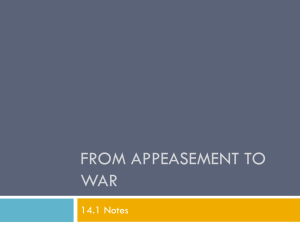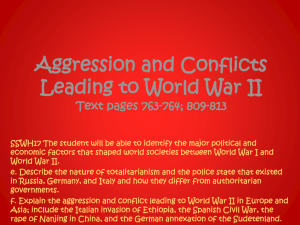History Sample Research Paper - Grand Valley State University
advertisement
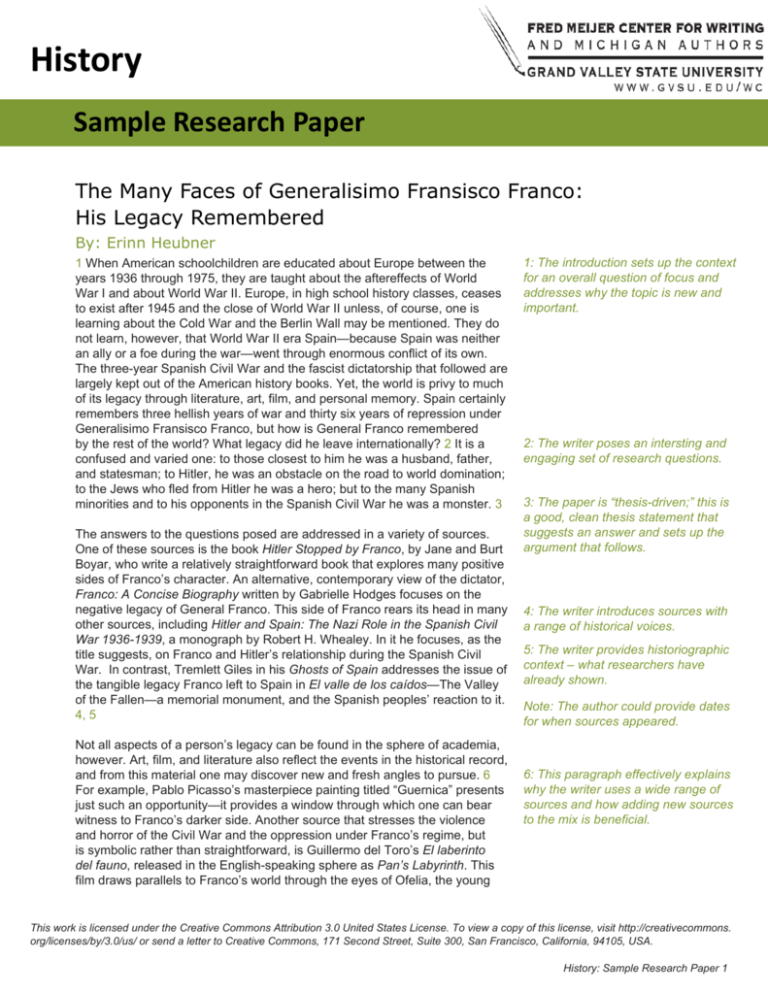
History Sample Research Paper The Many Faces of Generalisimo Fransisco Franco: His Legacy Remembered By: Erinn Heubner 1 When American schoolchildren are educated about Europe between the years 1936 through 1975, they are taught about the aftereffects of World War I and about World War II. Europe, in high school history classes, ceases to exist after 1945 and the close of World War II unless, of course, one is learning about the Cold War and the Berlin Wall may be mentioned. They do not learn, however, that World War II era Spain—because Spain was neither an ally or a foe during the war—went through enormous conflict of its own. The three-year Spanish Civil War and the fascist dictatorship that followed are largely kept out of the American history books. Yet, the world is privy to much of its legacy through literature, art, film, and personal memory. Spain certainly remembers three hellish years of war and thirty six years of repression under Generalisimo Fransisco Franco, but how is General Franco remembered by the rest of the world? What legacy did he leave internationally? 2 It is a confused and varied one: to those closest to him he was a husband, father, and statesman; to Hitler, he was an obstacle on the road to world domination; to the Jews who fled from Hitler he was a hero; but to the many Spanish minorities and to his opponents in the Spanish Civil War he was a monster. 3 The answers to the questions posed are addressed in a variety of sources. One of these sources is the book Hitler Stopped by Franco, by Jane and Burt Boyar, who write a relatively straightforward book that explores many positive sides of Franco’s character. An alternative, contemporary view of the dictator, Franco: A Concise Biography written by Gabrielle Hodges focuses on the negative legacy of General Franco. This side of Franco rears its head in many other sources, including Hitler and Spain: The Nazi Role in the Spanish Civil War 1936-1939, a monograph by Robert H. Whealey. In it he focuses, as the title suggests, on Franco and Hitler’s relationship during the Spanish Civil War. In contrast, Tremlett Giles in his Ghosts of Spain addresses the issue of the tangible legacy Franco left to Spain in El valle de los caídos—The Valley of the Fallen—a memorial monument, and the Spanish peoples’ reaction to it. 4, 5 Not all aspects of a person’s legacy can be found in the sphere of academia, however. Art, film, and literature also reflect the events in the historical record, and from this material one may discover new and fresh angles to pursue. 6 For example, Pablo Picasso’s masterpiece painting titled “Guernica” presents just such an opportunity—it provides a window through which one can bear witness to Franco’s darker side. Another source that stresses the violence and horror of the Civil War and the oppression under Franco’s regime, but is symbolic rather than straightforward, is Guillermo del Toro’s El laberinto del fauno, released in the English-speaking sphere as Pan’s Labyrinth. This film draws parallels to Franco’s world through the eyes of Ofelia, the young 1: The introduction sets up the context for an overall question of focus and addresses why the topic is new and important. 2: The writer poses an intersting and engaging set of research questions. 3: The paper is “thesis-driven;” this is a good, clean thesis statement that suggests an answer and sets up the argument that follows. 4: The writer introduces sources with a range of historical voices. 5: The writer provides historiographic context – what researchers have already shown. Note: The author could provide dates for when sources appeared. 6: This paragraph effectively explains why the writer uses a wide range of sources and how adding new sources to the mix is beneficial. This work is licensed under the Creative Commons Attribution 3.0 United States License. To view a copy of this license, visit http://creativecommons. org/licenses/by/3.0/us/ or send a letter to Creative Commons, 171 Second Street, Suite 300, San Francisco, California, 94105, USA. History: Sample Research Paper female protagonist who is struggling in an atmosphere of parental oppression. Manuel Rivas, in his short story La lengua de las mariposas (or Butterfly tongues), gives his readers a similar child-like perspective, but his is that of a little boy who struggles to understand the changes in his life brought about by the Civil War. One particularly interesting piece of literature that tries strenuously to highlight Franco as the family man is Hitler Stopped by Franco, a “novelized” history, written by Jane and Burt Boyar.1 Naturally one’s family would be hard-pressed to believe in the darker side of an individual. Franco’s family was no different. In their memories, as Jane and Burt Boyar would have one believe, he was a loving and affectionate husband and father. On October 22, 1923, Franco married Maria del Carmen Polo in a lavish public ceremony.2 The Boyars would indicate that his wife revealed to them that her parents disapproved of her choice in suitors, and she could not “have imagined that he would be as devoted a husband and father as he was.”3 They portray her as privy to his strategies as ruler of Spain, and in their conversations in the book, Carmen Polo affectionately calls her husband Paco, the endearment common in the Spanish language for Fransisco: “Paco, what are you going to do about the Germans?”4 This would prove Franco to be accessible, intimate with his wife, and open with her about the state of Spain and his decisions regarding her. 7 7: In this paragraph the writer comments on the sources and authors while displaying an awareness of the General Franco’s daughter, Carmen, was born on September 14, 1926.5 source of the author’s bias. Carmencita’s memory according to the Boyars is similar. One of the first incidences of her in the Boyars’ book is Franco’s concern for her safety-the concerned father. The Boyars describe Franco’s choice in palaces after he came to power: When he elected to move to the traditional capital, Madrid, his wife, Carmen Polo, selected the Palace of Larios in the city proper, but the Chief of Security vetoed the site because it was surrounded by higher buildings from which a sniper could shoot at the Generalisimo, his wife or daughter as they walked in the garden.6 8 Franco chose a more isolated, and therefore more secure location in which to house his family, the Palace of El Pardo.7 Another scene in the Boyars’ book in which we see Carmen and her father together shows us Franco, the father and host: “He was happy to see Carmencita’s best friend, Maruja Jurado, and kissed her hello…they (the Francos) encouraged her friends to visit.”8 In Carmencita’s own memory not only was Franco warm and intimate with his family, but with her friends and visitors as well. 9 While it may be true that Carmen Polo, Franco’s wife, and Carmencita had the closest relationship with the Generalisimo, there are two problems with the portrait of loving husband and doting father painted by the Boyars. First, there is conflicting evidence. One year before Hitler Stopped by Franco was published, Gabrielle Ashford Hodges wrote Franco: A Concise Biography. One passage in particular deserves to be quoted at length, as the image it conjures is directly contrary to the one the Boyar’s offer: 10 Carmen’s romantic notions cannot have lasted long. Although their marriage was more enduring than that of Franco’s parents, it was devoid of any sign of passion or great love from the very start. Once his role as the gallant and knightly supplicant for her favours was removed, Franco was exposed as a cold and physically inhibited man. More at ease with wooing women than winning their favours, he clearly preferred the battlefield to the marital bed. The union became increasingly formal over the years, with Pacón (Franco’s cousin) commenting that Franco always became particularly morose and inhibited in his wife’s company.9 8: The writer provides context as necessary. Note: Author’s awareness of problems with evidence in sources. 9: After providing context, the writer provides analysis. 10: This is a good portrayal of contrary evidence. History: Sample Research Paper 11 Hodges’s account and Pacón’s comment belie the image of Franco and his wife snuggled in bed, she calling him Paco and asking him to share his next move for planning the future of Spain, in light of the Nazi army’s advances in Europe. The second problem is that almost all of these instances come from the memory of Carmen Franco, Franco’s daughter, Duchess of Franco. The problem lies not in the woman, but in memory itself. The events that she describes as having taken place, as recorded by the Boyars, happened in 1940, when Carmen was only fourteen years old. 12 By the time the Boyars began their research into the topic—1969 at the earliest—Carmen was fortythree years old, and was remembering events and conversations almost three decades past. In his book, The Past is a Foreign Country, David Lowenthall addresses the issue of memory and how it can shape and misshape history. A common theme that Lowenthall addresses is that of memory and identity, and that we see ourselves as a construct of our memories. This can lead, Lowenthall explains, to false memories.10 Part of Carmen Franco’s identity resides in the memories she has of her father. Lowenthall tells his readers that “a false recollection firmly believed becomes a fact in its own right.”11 She wished to remember him as indulgent and doting, and so she did. And he may have been, but she was young and probably removed from the political atmosphere in which he showed his other faces. 11: The writer could also comment on Hodges’ sources. 12: This comment on nature of memory demonstrates awareness of source limitations and of how the source was produced. (The nature of memory is an important topic for historians.) 13 Furthermore, Lowenthall argues that children remember things differently than adults do: “Children see and hear what is there; adults see and hear what they are expected to and mainly remember what they think they ought to remember.”12 Carmen’s memories as a young girl focus on Franco the father, because that is the Franco she knew. She undoubtedly was not privy to political meetings or even so-called grown up discussions between her mother and father. Her memories of her father are biased because of her age when those memories were formed. Perhaps the most troublesome, however, is the span of time between her recollections and the actual events. Almost three decades passed before she reconstructed her memories for the Boyars. Lowenthall gives his readers an example of another woman, Marigold Linton, who believed that she could accurately reconstruct her memories from thirty years prior. She kept a diary for a year, highlighting events in her life, which she revisited two years later and again three or four years after writing it in 1972. 14 Lowenthall describes her findings: they “revealed that memory grossly altered events recorded two years back; after three or four years many items failed to trigger any recollection at all…after six years one-third of her recorded events had entirely vanished from memory.”13 If after six years one-third of her memories were irretrievable, imagine how many would have vanished by the thirtieth! Carmen Franco’s memories were genuine and very real to her and her circumstances, but they may not be all that reliable. Regardless, Franco’s legacy for her is that of the family man. 13: This paragraph also shows awareness of how sources are constructed. 15 Another positive piece to Franco’s legacy comes to us in the form of his position as a roadblock to Hitler in the Fürher’s ambition to conquer the continent of Europe. Germany’s army wanted into North Africa, and they also needed a strategic location from which they could blockade Britain’s supply lines. This prime location was Gibraltar, the southernmost point of the Spanish mainland.14 Germany faced a problem, however: Gibraltar had been under British control since 1782, and Britain formally made it a royal colony in 1830. The only way for German forces to reach Gibraltar was through Spain. Hitler began his provocations on June 27, 1940 with a large show of force at the French-Spanish border.15 Franco stalled, waiting to do anything until he received a letter from Hitler on September 18. In this letter, Hitler outlined his views of the importance of this war in the future of Europe, and laid out what he thought Spain’s role ought to be in it. Their role would, of course, be the capture and occupation of Gibraltar with the aid of German equipment and forces under Spanish command.16 This letter, combined with the amassed 15: This is a logical transition. 14: Effectively shows the evidence the source used. History: Sample Research Paper armies at the border, reflects a kind of polite ultimatum: let my armies in, or be occupied. Franco stalled again, responding to Hitler’s letter in his own, dated September 22, 1940. He responded cleverly to Hitler’s offer of modern equipment and German troops to take Gibraltar.16 He wrote, “I agree with your view that it is possible to achieve the success of this operation within a few days by the use of modern equipment and tried troops. In this sense the equipment which you offer me will be of great effect.”17 Franco responded in such a way that he was properly appreciative of Hitler’s offer, but also in a way that rebuffed Hitler’s attempt to bring German troops into Spain. After an unsuccessful attempt to convince Franco that he should bring Spain into the war as an ally of Germany, the two dictators met in person for the first and last time on the Spanish-French border, at Hendaye.18 In his book Hitler and Spain: The Nazi Role in the Spanish Civil War, Robert Whealey describes the October 1940 event as a “chilly meeting.”19 Hitler, again, failed to convince Franco to take Gibraltar immediately. In February of the next year, Hitler again wrote to Franco, but this time using stronger language: “I asked you…to permit the German concentration of forces against Gibraltar to start by January 10th…”20 Hitler was growing increasingly frustrated with General Franco’s ability to put him off, as Franco did in response to his February letter, with more pleasant, appreciative talk but no action.21 Hitler sought to send a still more effective message. Later in the same year, German U-boats torpedoed and sank the Monte Gorbea, a Spanish grain ship bound for Spain with much-needed wheat.22 Despite his country’s desperate need for grain and staples to feed his people, Franco did not allow Hitler’s troops onto Spanish soil and on June 20, 1943, after almost three years, the German army left the Spanish border and retreated back into France.23 Hitler did not take Gibraltar, and Franco is the man who is remembered for stopping what could have been a devastating blow to the British navy—a blow that could have changed the course of the war. 17 18 In the course of disobeying Hitler’s thinly disguised demands, Franco also saved the lives of “at least 40,000” Jews fleeing France in front of the German army.24 In an article published in his honor after his death in The American Sephardi, Franco was credited with not only denying Hitler in his attempt to make Franco pass anti-Semitic legislation, but he also repealed the law that expelled the Jews from Spain in 1942. He also founded Departments of Jewish Studies in all the major Spanish universities, wrote a law giving permission for public worship in all non-Catholic religions, and restored the Tránsito Synagogue of Toledo into a museum of Judaism until the time when it could be opened for worship again.25 In purposely going against Hitler by allowing refugees from Nazi France into Spain, and in his proactive approach to restoring positive official relations between the Catholic regime and the Jewish people, Franco set a place for himself as hero in the minds and hearts of the international Jewish community as well as the Spanish one. However, General Franco had not always gone contrary to Hitler. During the Spanish Civil War, from 1936 to 1939, the Republicans—the leftist party—fought against the Nationalists—the conservative party—for control of the government. General Franco, a highly skilled and courageous soldier and brigadier general by the age of 34, led the Nationalist armies.26 Many of the men who followed him on the battlefields of North Africa followed him into the war, so that the Nationalist cause had the benefit of professionally trained soldiers while the Republican forces were mostly militia and civilians. Franco used the full power of the army and he took aid from Hitler. Whealey describes in Hitler and Spain that Franco “told the German ambassador that the services of the ‘Legion Condor could not be dispensed with.’”27 Franco used especially the Luftwaffe, since often he had the infantry support he needed, being a respected general of the Spanish Army. 19 16: The writer effectively introduces the sources being addressed. 17: This paragraph shows a strong chronological progression of events in narrative form; the chronology is used to create strong transitions and logical organiztion. Also, the writer again effectively sets up the context. 18: This is a strong transition that shows how Franco’s actions benefited various groups. 19: This paragraph develops further context for assertions regarding Franco’s behavior. History: Sample Research Paper One especially famous instance of the Luftwaffe bombing was Gernika, formerly the capital of the Basque Country in north-central Spain. Whealey describes the bombing in a rather sterile way: On April 26, 1937, the Luftwaffe bombed the Basque village of Guernica. A few days later Franco’s forces captured the town and tried to deny the bombing for the sake of international public opinion. This led to a series of charges and countercharges, so that the story of this relatively minor military event became a study in morality, international law, and propaganda.28 He goes on to explain that Gernika was an experiment in a new bombing campaign that Franco decided not to pursue after public outcry ensued. He did consider it a success; however, with 1,000 civilians dead, they still missed what they aimed for—a munitions factory and a strategic bridge.29 Much of the city was destroyed by fire. (See figure A below). 20 Franco worked with Hitler during the bloody Civil War to meet his own ends (what he envisioned for Spain), and in this one case especially, to be a practice range for the fledgling Luftwaffe. The means through which he accomplished those ends, however, often come under scrutiny and not just in historical or political circles. Painter Pablo Picasso was born in Málaga, Spain in 1881. He was a supporter of the Republicans and because of this, he lived most of his adult life in France. In January of 1937, the Republican government commissioned a painting to represent Spain’s struggle at an exhibition in Paris—a propaganda piece. After the bombing of the village, however, the painting was rededicated to symbolize the suffering and horror that Gernika suffered, and so the Republicans renamed it “Guernica.” The painting is completely devoid of color, but Picasso painted it in black, white, and gray for a reason.30 The black represents the despair and hopelessness of the people of Gernika, mourning for the thousands of lives lost in the bombing. The white is meant to be polarizing, a contrast to the darkness, emphasizing the innocent lives that were lost, but also symbolizing hope—hope that Spain would one day see peace and an end to the bloody Civil War that claimed so many of its men, women, and children. (See Figure B below). 21 Jane and Burt Boyar had something to say about the way Franco was able to run the Civil War and his dictatorship after the war: “when you had to sign death warrants for thousands of men, when you had to look into a prisoner’s eyes and say, ‘Execute him,’…when ones’ emotions have been subjected to all those things then perhaps understanding occurs before anger.”31 The context of this statement is not to highlight the actions of the killing of thousands or the execution of a political prisoner, but to emphasize the efficiency of Franco’s actions, his ability to be a statesman, and do what was necessary: “he tolerated the intolerable, accepted the unacceptable—anything to save Spain.”32 The concept is too Machiavellian, however: the endlessly paraphrased ‘the ends justify the means’ is no longer acceptable in a ruler. This statement by the Boyars, then, depending upon its reader, makes Franco seem somehow less than human, incapable of the emotion that stays one’s hands from committing atrocities and makes his legacy ring more truly in the realm of monster. 22 The most poignant example of this legacy is a film by writer, producer, and director Guillermo del Toro. The film is called El laberinto del fauno, or in English, Pan’s Labyrinth. Del Toro released the film in 2007, thirty two years after the end of Franco’s dictatorship. 23 The scene is set in 1944, after the official end of the Civil War, but there are still skirmishes between Francoan soldiers and leftist rebels. Ofelia, the main character, is a young girl whose 20: In history writing, it is good to reference supportive figures/images. 21: This is a good analysis of an illustration; illustration is effective here because it is not a filler, but instead is evidence as part of the argument. 22: This is a good setup to lead into the next paragraph. 23: It is beneficial to give the historical context of the film–attention is on the time period of focus. History: Sample Research Paper mother recently married a Captain in Franco’s army. Immediately the viewer, if they have any knowledge of Shakespeare’s works, should know that tragedy lies in the young girl’s future. Ophelia is the lover of Hamlet in the play by the same name, and she meets an untimely demise. Ofelia is a freespirited young girl, and she disobeys often and gets herself into mischief.33 She represents a free Spain, out from under the repression of Franco’s fascist regime. Her struggle mostly lies with her new stepfather, Captain Vidal, who represents Francoan authority. He is the only figure of authority in the film and his authority is absolute. The caretaker of the mill where all the main characters live is Mercedes, a leftist spy who provides intelligence and sustenance to the rebels in the mountains. She is meant to be an older version of the Ofelia character.34 Both disobey the Captain’s authority and make their own choices. 24 There are two scenes in the film that blatantly show the ability of the Captain to be like Jane and Burt Boyar describe, without anger, but capable of doing horrible things. One scene takes place at night, when the Captain is called outside to question two men—father and son—found walking in the mountains with rifles. They are accused of being spies and rebels, but they insist that they were just hunting rabbits. The captain does not believe them. The son steps forward and speaks up to defend his father: 24: In this paragraph, the writer effectively provides more information regarding historical and literary context. —Captain, if my father says so, he was hunting rabbits. The captain does not respond but simply hits the son across the face with a bottle he found in their pack and proceeds to beat the son’s face in with the blunt end of the bottle until his nose splinters and he dies. His father’s cries echo in the background: —You killed him! You killed him! Murderer! Son of a bitch! The captain very calmly turns to the father and shoots him through the heart. If one watches the captain’s face very carefully, one can see no emotion there, but just an efficient army officer carrying out the everyday atrocities of fascist repression. Before he leaves his soldiers to clean up, he finds two rabbits in the same pack from which he pulled the wine bottle. He says to his soldiers: —Maybe you’ll learn to search these assholes properly before you come bothering me.35 This is the kind of nonchalant brutality that the Boyars bring to mind when they describe Franco as being able to sign the death warrants of thousands without getting angry. No man should order the deaths of thousands, let alone be cool and collected while doing so. Another scene that evokes pity for the leftist rebels and highlights the control and oppression of Franco’s Spain is one in which the Captain hands out ration cards to the Nationalist villagers in the area. The idea is to keep the food, medicine, and other supplies locked up at the mill, doling them out bit by bit so that no one can either directly or inadvertently help the rebels by supplying them with anything. Even the priest sitting at the table does not seem troubled with starving them to death and letting them die of disease, saying: —God has already saved their souls. What happens to their bodies hardly matters to Him. The Catholic Church was one of Franco’s staunchest supporters. The Vatican eventually gave him “full diplomatic recognition.”36 The Captain chillingly sums it up: History: Sample Research Paper —I want my son to be born in a new, clean Spain. Because these people hold the mistaken belief that we’re all equal. But there’s a big difference: the war is over and we won. And if we need to kill every one of these vermin to settle it, then we’ll kill them all, and that’s that. This way of thinking was too much for some people, however. Ofelia’s mother, after discovering her daughter still believes in fairy tales, grows angry, and yells at her: —You have to stop all this. —No! I want to leave this place! Please, take me away from here! Let’s just go, please! —Things are not that simple. You’re getting older, soon you’ll see that life isn’t like your fairy tales. The world is a cruel place. And you’ll learn that even if it hurts… —No! No! —Ofelia! Magic does not exist! Not for you, me, or anyone else.37 Her mother has lost hope, not just in fairy tales and magic as the conversation suggests, but in the ability of Spain to recover, to thrive under the repressive regime of Franco. Ofelia has hope, however, and the viewer can see it in two things. First of all, she has her fairy tales. She creates for herself an alternate reality that she can escape to when the real world of her stepfather’s oppressive environment gets to be too much for her. In her alternate reality, she is a princess from a fairy kingdom underground and to get back there, all she has to do is complete three tasks, then she will be immortal again and return to her true destiny in the land of fairies and magic, free of suffering. Del Toro uses colors as symbols in this film, and it is excellently done. The harsh, oppressive reality of the Captain is shot mainly with cold colors, muted colors: blue, green, and gray. The alternate reality is shot in rich colors of red, orange, and gold. Second, at the end of the film, the viewer realizes that the journey that Ofelia took—from a carefree young girl, to suffering under the captain’s roof and rules and dying at his hand and then being resurrected as her true fairy princess form—this is the journey that Spain took under General Franco: from relative peace before the Civil War, to suffering under Franco’s war and 36-year-long regime, to being resurrected into the modern Spain under the rule of a democratic monarchy. Guillermo del Toro put it beautifully when he wrote on the film’s web site: “Franco suffocated Spain for decades as he tried to fashion it after what he believed to be ‘good for her.’ Yet Spain didn’t die; she exploded, vibrant and alive, in the 80s. Spain lived the 60s in the 80s and they are still feeling the aftershocks of such a wonderful explosion.”38 The girl believed enough in her magic, in her fairy tales, not to be afraid even as death took her; because she knew something better awaited her on the other side; because she made the brave choice not to sacrifice the innocent and to hold on to hope. Ofelia’s perspective is almost unique, because it is a perspective not often explored in history. It presents the world of Franco through the eyes of a child. 25 Manual Rivas also explores this child’s perspective in his short story La lengua de las mariposas. In his story, Pardal is a young boy who is just starting school for the first time. His father is a Republican sympathizer and his mother is a Nationalist. After a traumatic experience his first day at school, the boy forms a bond with his teacher who helps him to understand the world of creatures that live right in his mountainous backyard. Two of his favorites are the toad, because it reminds him of his teacher, and a butterfly called the Iris that “brillaba hermosisima posada en el barro o el esiércol”39 (that shone 25: This is an effective shift from Ofelia to Manual Rivas. History: Sample Research Paper most beautifully laid in the mud or manure). His parents revel in the attention he receives from the teacher and the progress he makes in his studies. His father, a tailor, even makes a new suit to show the teacher their gratitude. When the Civil War struck and the Nationalist police came to their village and began taking prisoners, Pardal’s mother took him aside and told him “con voz muy grave: Recuerda esto, Moncho, Papá no era republicano. Papá no era amigo del alcalde. Papá no hablaba mal de los curas. Y otra cost muy importante, Moncho. Papá no le regaló un trage al maestro”40 (in a very serious tone: Remember this, Moncho, Daddy was not a Republican. Daddy was not a friend of the mayor. Daddy did not talk badly about priests. And one other very important thing, Moncho. Daddy did not give a suit to the teacher). The boy is confused: “Sí que se lo regaló” (But he did give it to him). “No, Moncho. No se lo regaló. ¿Has entendido bien? ¡No se regaló!” (No, Moncho. He did not give it to him. Do you understand me? He didn’t give it to him!). Moncho responds, “No, mama, no se lo regaló” (No, Mom, he didn’t give it to him).41 Then the whole town gathers in the courtyard in front of City Hall, and the police bring out the political prisoners. His teacher is among them. The crowd begins to shout, call them names, and accuse them of treason. Pardal’s mother tells his father to make sure the crowd sees him yelling, too, so they’ll know he’s one of them, “los ojos llenos de lágrimas y sangre”42 (his eyes full of tears and blood), and he tells his son that he needs to yell, too. Moncho recalls a heart wrenching scene: Cuando los camions arrancaron, cargados de presos, yo fui eno de los ninos que corrieron detrás, tirando piedras. Buscaba con desesperación el restro del maestro para llamarle traidor y criminal. Pero el convoy era ya una bune de polvo a lo lejos y yo, en el medio de la Alameda, con los punos cerrados, solo fui capaz de murmurar con rabia: ‘¡Sapo! ¡Tilonorrinco! ¡Iris!’43 (When the trucks started, full of prisoners, I was one of the children that ran behind, throwing rocks. I desperately searched for the face of the teacher so I could call him a traitor and a criminal. But the convoy was already a distant cloud of dust and I, in the middle of the courtyard, with fisted hands, was only capable of whispering furiously: ‘Toad! Tilonorrino! Iris!’). Pardal was desperately hoping to find his friend to call him horrible things, and when he could not find him and the frenzy of the moment was over, he was furious without knowing why, and the only things he could think of to whisper were those beautiful creatures that his teacher had taught him to love, especially the one—the Iris—that, like his teacher, still shone brilliantly, though it may lay in the mud and manure. For this young boy this is the legacy that Franco left for him to deal with: It split families, it caused confusion, made enemies out of neighbors. Fear created monsters out of normal people, and people were angry and agitated without knowing why, especially the children. The emotions and confusion caused by war and the fear caused by repression are difficult for children to evaluate and understand. They must mature before their time. Finally, one cannot ignore the legacy that Franco himself sought to leave for the country he ruled for almost four decades. 26 In Ghosts of Spain: Travels Through Spain and Its Silent Past, Giles Tremlett discusses briefly the monument that Franco built. Called El valle de los caidos—the Valley of the Fallen—it “is built to impress. From the cross and the basilica to the bleak esplenade…all here is large and imposing. The scale of and drama of the Valley of the Fallen guarantee the name of Francisco Franco will survive for centuries.”44 (See Figure C below). He made sure of that considering that of 26: This is another example of a logical transition. History: Sample Research Paper the 40,000 dead from the Civil War interred in the monument, only Franco’s name and that of one Nationalist martyr are recorded. Furthermore, Franco’s resting place is directly behind the altar in the vast underground basilica.45 It is almost as though Franco did not care how history remembered him, his place in the basilica screams, “Look at me! I’m a saint!” It appears to be a monument to the ego of General Franco, a Catholic place of worship, and a fascist reunion hall where the admirers of Franco pay their respects once a year. Officially, however, it was meant to be a reconciliation monument, an homage to all the fallen of the Spanish Civil War.46 Tremlett tells his readers that he had invited some of his Spanish friends to visit the monument with him, and they responded in kind: “¡Ni muerto!”47 (Not even dead!). They see the hypocrisy inherent in the monument itself. If it were truly to be a reconciliation, it would not be a Catholic basilica, because the Republicans felt no great affection for the Catholic Church. It would not feature Franco in a prominent tomb, located in a place usually reserved for saints. It would not hold Franco’s homage ceremony in a place meant to honor all of the fallen, and finally it would list all the names of the dead, Republican and Nationalist alike, instead of listing only the names of the leader of the Nationalist government and a nationalist martyr. Francisco Franco’s legacy comes to us from a number of sources: in literature, there’s the “faction” book by the Boyars that incorporates many perspectives. First is the perspective of the child Carmencita, who remembers her father, the man; second is the perspective of Hitler, who found Franco frustrating and a block to his expansionist plans third is the perspective of the Jews who benefited from Franco’s open border policy and pro-Semitic legislation. Also in literature, in La lengua de las mariposas, comes the perspective of a child who gets wrapped up in nationalist rhetoric and fervor, but doesn’t understand it. In art, Pablo Picasso brings us an image of hope and despair, a dichotomy that few succeeded in expressing, except, perhaps, our heroine of the film El laberinto del fauno, who, because of her innocence and her belief in fairy tales, finds hope in the darkest of Francoan repression. Finally, of course, is the self-image that Franco left for all to see in the monument to himself and his party, the Valley of the Fallen. Some historical figures’ mythology is solid and unified, but Franco was a multi-faceted man, and so his legacy is also fractured and contested. 27 Strengths: 1. Sets up evidence & thesis in intro—explains why paper is being written (why thesis is unique) 2. Introduces Sources (introduces author, date/context, perspective, audience, genre) 3. Smooth Transitions between paragraphs & sections; transitions are rich & meaningful (not just “and now we will discuss…”) 4. Good use of chronology to reconstruct sequence; note effective use of flashback w/ Spanish Civil War (reverse chronology) 5. Engages existing literature & shows where his/her work fits (historiography) 6. Solid grammar & prose 27: This is a strong concluding paragraph that brings out why the argument works and how the conclusion is derived from solid evidence. History: Sample Research Paper Figure A: http://efectomariposa.ixine.com/2007/04/ Figure B: http://www.spanisharts.com/reinasofia/picasso.htm Figure C: http://100falcons.wordpress.com/2008/04/08/the-valley-ofthe-fallen/ History: Sample Research Paper 10 Notes 1. Jane and Burt Boyar. Hitler Stopped by Franco (Marbella House, 2001), vii. 2. Gabrielle Ashford Hodges. Franco: A Concise Biography (New York: St. Martin’s Press, 2000), 49-50. 3. Boyar, Hitler Stopped, 59. 4. Boyar, Hitler Stopped, 60. 5. Hodges, Franco, 53. 6. Boyar, Hitler Stopped, 12. 7. Boyar, Hitler Stopped, 14. 8. Ibid., 24. 9. Hodges, Franco, 50. 10. David Lowenthall. The Past is a Foreign Country (New York: Cambridge University Press, 1985), 200. 11. Lowenthall, The Past, 200. 12. Ibid., 202. 13. Ibid., 206. 14. Robert H. Whealey. Hitler and Spain: The Nazi Role in the Spanish Civil War 1936-1939 (Lexington, Kentucky: University Press of Kentucky, 1989), 116; Boyar, Hitler Stopped, 57. 15. Boyar, HItler Stopped, 56. 16. Adolf Hitler. Letter to Francisco Franco, 18 September 1940. In Hitler Stopped by Franco, Jane and Burt Boyar (Marbella House, 2001), 291. 17. Francisco Franco. Letter to Adolf Hitler, 22 September 1940. In Hitler Stopped by Franco, Jane and Burt Boyar (Marbella House, 2001), 295. 18. Boyar, Hitler Stopped, 129; Whealey, Hitler and Spain, 141. 19. Whealey, Hitler and Spain, 141. 20. Adolf Hitler. Letter to Francisco Franco, 6 February 1941. In Hitler Stopped by Franco, Jane and Burt Boyar (Marbella House, 2001), 305. 21. Francisco Franco. Letter to Adolf Hitler, 26 February 1941. In Hitler Stopped by Franco, Jane and Burt Boyar (Marbella House, 2001), 310-311. 22. Boyar, Hitler Stopped, 237. 23. Boyar, Hitler Stopped, 271-272. 24. H.P. Salomon and Tomás L. Ryan. “In Memoriam: Francisco Franco (1892-1975), Benefactor of the Jews.” The American Sephardi: Journal of the Sephardic Studies Program of Yeshiva University IX, (1978): 215. 25. Salomon, “In Memoriam,” 215-218. 26. Hodges, Franco, 25, 33, 44-5, 52. 27. Whealey, Hitler and Spain, 108. 28. Whealey, Hitler and Spain, 103-104. 29. Ibid., 106. 30. “Picasso.” Reina Sofia National Museum. 10 April 2008 <http://www.spanisharts.com/reinasofia/picasso.htm>. 31. Boyar, Hitler Stopped, 58. 32. Boyar, Hitler Stopped, 60. 33. El laberinto del fauno. Dir. Guillermo del Toro. Perf. Ivana Baquero, Sergi López, Maribel Verdú, and Doug Jones. Tequila Gang, 2007. 34. Guillermo del Toro. El laberinto del fauno. Special Features, “Power of the Myth.” 35. El laberinto. 36. Hodges, Hitler Stopped, 115. 37. El laberinto. 38. Guillermo del Toro. “About the Filming.” Pan’s Labyrinth. 10 April 2008 <http://panslabyrinth.com>. 39. Manuel Rivas. La lengua de las mariposas (Berlin: Cornelsen Verlag, 2004), 13. 40. Rivas, La Lengua,15-16. 41. Ibid., 16. 42. Ibid., 17. 43. Ibid. 44. Giles Tremlett. Ghosts of Spain: Travels Through Spain and Its Silent Past (New York: Walker & Company, 2006), 47-48. 45. Tremlett, Ghosts of Spain, 44. 46. Ibid. 47. Ibid., 43. History: Sample Research Paper 11 Bibliography Boyar, Jane and Burt. Hitler Stopped by Franco. Marbella House, 2001. Franco, Francisco. Letter to Adolf Hitler. 22 September 1940, published in Jane and Burt Boyar. Hitler Stopped by Franco. Marbella House, 2001. Franco, Francisco. Letter to Adolf Hitler. 26 February 1941, published in Jane and Burt Boyar. Hitler Stopped by Franco. Marbella House, 2001. Hitler, Adolf. Letter to Francisco Franco. 18 September 1940, published in Jane and Burt Boyar. Hitler Stopped by Franco. Marbella House, 2001. Hitler, Adolf. Letter to Francisco Franco. 6 February 1941, published in Jane and Burt Boyar. Hitler Stopped by Franco. Marbella House, 2001. Hodges, Gabrielle Ashford. Franco: A Concise Biography. New York: St. Martin’s Press, 2000. Lowenthall, David. The Past Is a Foreign Country. New York: Cambridge University Press, 1985. Salomon, H.P. and Tomás L. Ryan. “In Memoriam: Francisco Franco (1892-1975), Benefactor of the Jews.” The American Sephardi: Journal of the Sephardic Studies Program of Yeshiva University IX (1978), 215-218. Tremlett, Giles. Ghosts of Spain: Travels Through Spain and Its Silent Past. Whealey, Robert H. Hitler and Spain: The Nazi Role in the Spanish Civil War 1936-1939. Lexington, Kentucky: University Press of Kentucky, 1989. *Note use of both primary and secondary sources. The student has also used different types of secondary sources (in other words, the student provided a variety of genres—film, book, etc.). History: Sample Research Paper 12
